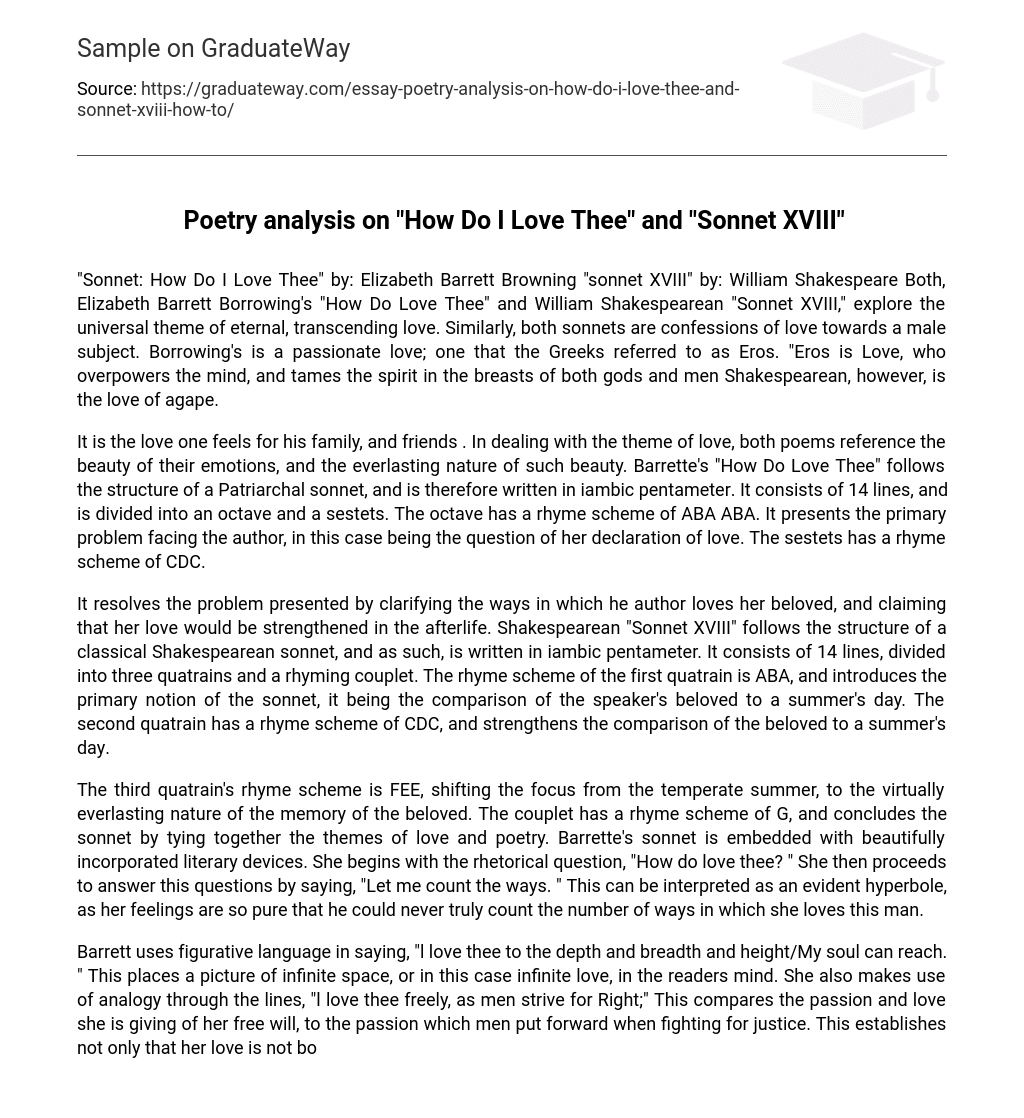“Sonnet: How Do I Love Thee” by: Elizabeth Barrett Browning “sonnet XVIII” by: William Shakespeare Both, Elizabeth Barrett Borrowing’s “How Do Love Thee” and William Shakespearean “Sonnet XVIII,” explore the universal theme of eternal, transcending love. Similarly, both sonnets are confessions of love towards a male subject. Borrowing’s is a passionate love; one that the Greeks referred to as Eros. “Eros is Love, who overpowers the mind, and tames the spirit in the breasts of both gods and men Shakespearean, however, is the love of agape.
It is the love one feels for his family, and friends . In dealing with the theme of love, both poems reference the beauty of their emotions, and the everlasting nature of such beauty. Barrette’s “How Do Love Thee” follows the structure of a Patriarchal sonnet, and is therefore written in iambic pentameter. It consists of 14 lines, and is divided into an octave and a sestets. The octave has a rhyme scheme of ABA ABA. It presents the primary problem facing the author, in this case being the question of her declaration of love. The sestets has a rhyme scheme of CDC.
It resolves the problem presented by clarifying the ways in which he author loves her beloved, and claiming that her love would be strengthened in the afterlife. Shakespearean “Sonnet XVIII” follows the structure of a classical Shakespearean sonnet, and as such, is written in iambic pentameter. It consists of 14 lines, divided into three quatrains and a rhyming couplet. The rhyme scheme of the first quatrain is ABA, and introduces the primary notion of the sonnet, it being the comparison of the speaker’s beloved to a summer’s day. The second quatrain has a rhyme scheme of CDC, and strengthens the comparison of the beloved to a summer’s day.
The third quatrain’s rhyme scheme is FEE, shifting the focus from the temperate summer, to the virtually everlasting nature of the memory of the beloved. The couplet has a rhyme scheme of G, and concludes the sonnet by tying together the themes of love and poetry. Barrette’s sonnet is embedded with beautifully incorporated literary devices. She begins with the rhetorical question, “How do love thee? ” She then proceeds to answer this questions by saying, “Let me count the ways. ” This can be interpreted as an evident hyperbole, as her feelings are so pure that he could never truly count the number of ways in which she loves this man.
Barrett uses figurative language in saying, “l love thee to the depth and breadth and height/My soul can reach. ” This places a picture of infinite space, or in this case infinite love, in the readers mind. She also makes use of analogy through the lines, “l love thee freely, as men strive for Right;” This compares the passion and love she is giving of her free will, to the passion which men put forward when fighting for justice. This establishes not only that her love is not bound, but also that it is strong, and honest.
An analogy an also be seen in the following line, as she states, “l love thee purely, as they turn from Praise,” insisting her love is as modest and pure as the hearts of those men who are striving for justice. The last line of the sonnet states, ‘ shall but love thee better after death. ” Death is somewhat ironic in this context, since it is both what ends the poem, and what ends life. Shakespearean introduces his sonnet with the line “Shall I compare thee to a summer day? ” In a sense, this foreshadows that the beloved will, in fact, be compared to a summer’s day.
Perhaps, even more than that, it foreshadows he use of metaphors throughout sonnet, as the comparison will be made. Shakespeare begins the comparison by drawing parallels between his beloved and the summer’s day, through the line “Thou art more lovely and more temperate. ” He carefully chooses his adjectives so that they may apply to both summer, and his beloved. He continues by stating that “rough winds do shake the darling buds of May. ” In this, he is using rough winds as a symbol of erratic chance and change, and implying that his beloved is superior because he does not suffer from these winds.
The author personifies he sky, or “heaven,” by using the metaphor of an “eye” in place of the sun. He further personifies the season by mentioning that the summer’s “gold complexion” is often “dimmed,” which compares yet another human attribute of his beloved, with a trait of summer. The author then assures his beloved that his “eternal summer shall not fade. ” Through this, he uses summer as a metaphor for beauty. The speaker brags that his beloved will never suffer the same fate as a summer’s day, because he has dedicated him to “eternal lines. ” This adds the theme of poetry to a sonnet that had, until now, been about love.





